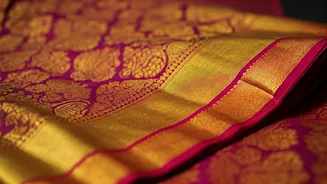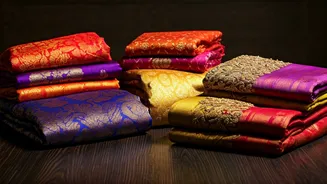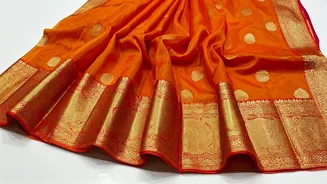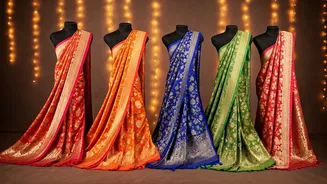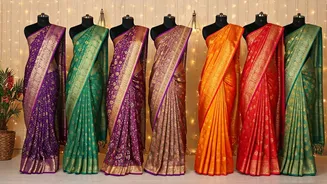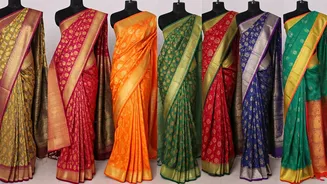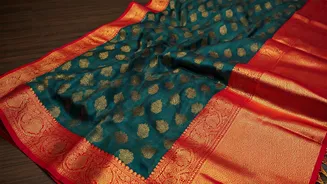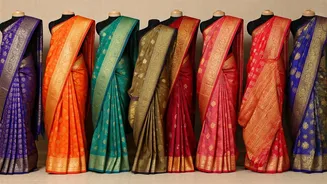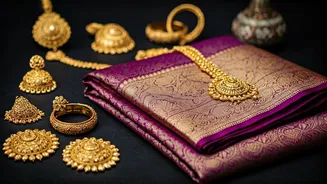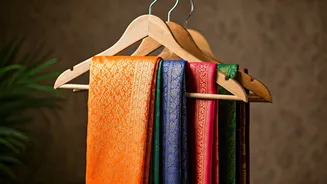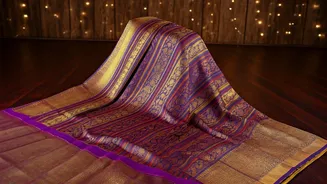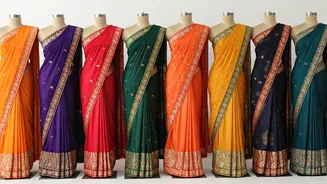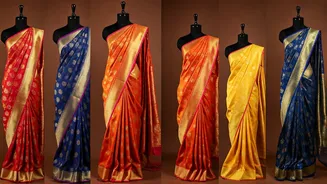Silk and Weave
The foundation of a genuine Banarasi saree rests on the quality of its silk and the weaving technique employed. Authentic sarees are crafted using pure
silk, recognizable by its smooth texture, natural sheen, and lightweight feel. Examine the fabric closely; it should have a subtle luster that changes with the light. The weave itself is a testament to the weaver's skill. Traditional Banarasi sarees often use intricate brocade techniques, where patterns are created by adding extra weft threads. This creates raised designs and rich textures on the fabric. Check for the density and precision of the weave. The closer and more uniform the weave, the higher the quality of the saree. Look for any loose threads or imperfections, as these can indicate lower quality or imitation.
The Intricate Designs
Banarasi sarees are renowned for their elaborate designs, featuring motifs inspired by Mughal art, nature, and geometric patterns. These motifs, often woven with gold or silver zari, add to the saree's opulence. Examine the motifs closely. The detailing should be sharp and precise, with no blurring or fading of the design. The zari work is another key indicator of authenticity. Real zari is made from gold or silver-coated threads, which will have a distinct gleam and weight. Look for the quality of the zari; the finer the zari, the more luxurious the saree. Traditional motifs include floral patterns (butis and bel), paisleys (kardhials), and animal figures. Each motif should be carefully crafted, displaying the weaver's expertise. The color combinations and the overall design aesthetics need to be consistent to mark the authenticity of a Banarasi saree.
Zari Work Examination
Zari, or the metallic thread used in Banarasi sarees, is a crucial element that contributes to the saree's value and appearance. The quality and type of zari can significantly impact the saree's price and authenticity. Authentic Banarasi sarees use genuine zari made from gold or silver threads. These threads add weight and a distinct metallic luster to the fabric. Examine the zari closely. Real zari should have a smooth, even texture and a rich, metallic shine that doesn't fade easily. The density of the zari work also indicates quality. The more intricately zari is used in the design, the more valuable the saree. Beware of sarees that use imitation zari, which may appear shiny but lacks the weight and quality of genuine metallic threads. These imitations often look dull and tarnish easily. Gently rub the zari. Genuine zari is less likely to wear off or change color. Carefully analyze the weave of the zari into the silk fabric.
The Saree's Weight
The weight of a Banarasi saree can be a good indicator of its authenticity and quality. Since genuine Banarasi sarees use pure silk and intricate zari work, they tend to have a certain weight. Real silk has a natural density that contributes to the saree's overall weight. Examine the saree's weight, keeping in mind the size. Heavier sarees often indicate the use of pure silk and elaborate weaving techniques. The zari work will also add to the weight of the saree. Sarees with more zari will naturally be heavier. Heavier sarees typically command a higher price, reflecting the craftsmanship and materials used. Compare the weight of different sarees. If you are comparing a few sarees, those with more detailed and complex designs will often weigh more. However, the weight alone is not the sole factor in determining authenticity; it should be considered alongside other features.
Check the Price
Price is often a crucial indicator of the authenticity of a Banarasi saree. Genuine Banarasi sarees, crafted with pure silk, intricate zari work, and skilled craftsmanship, come with a premium price tag. Research the average price range for authentic Banarasi sarees. Prices can vary widely based on the complexity of the design, the quality of silk, and the amount of zari used. Be wary of sarees offered at prices that seem too good to be true. Extremely low prices often indicate imitation fabrics, synthetic materials, or mass-produced designs. The price reflects the time, effort, and materials that go into making an authentic Banarasi saree. Check the seller's reputation and verify the saree's origin. Authentic Banarasi sarees are often sold by reputable vendors, directly from weavers or established retailers. If you are purchasing online, carefully review the seller's reviews and return policies. The combination of all factors, including the price, will help in making an informed buying decision.
